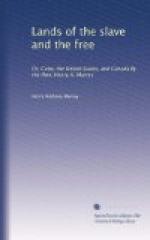What a wondrous place is this Buffalo!—what a type of American activity and enterprise! I had visited it in the year 1826, and then it had only three thousand inhabitants. The theatre, I remember, amused me immensely, the stage and accommodation for spectators barely occupying an area of twenty-five feet square. Mr. G.V. Brooke’s boxes, at that time, would have filled the whole house; and here they are in 1852, drawing our metropolitan stars to their boards. Their population has increased twenty-fold, and now exceeds sixty thousand; a splendid harbour, a lighthouse, piers, breakwater, &c., have been constructed, and the place is daily increasing. Churches rear their spiry steeples in every direction. Banks and insurance offices are scattered broadcast. Educational, literary, and benevolent establishments abound, and upwards of a dozen newspapers are published. Land which, during my visit in 1826, you might almost have had for the asking, is now selling at two hundred guineas the foot of frontage for building. Even during the last ten years, the duties collected at the port have increased from L1000 to nearly L14,000. In the year 1852 upwards of four thousand vessels, representing a million and a half of tonnage, cleared at the harbour, and goods to the value of nearly seven millions sterling arrived from the lakes, the greater portion of the cargoes being grain. The value of goods annually delivered by Erie Canal is eight millions. Never was a more energetic hive of humanity than these “Buffalo lads;” and they are going ahead every day, racing pace.
Now, John Bull, come with me to the cliff outside the town, and overhanging the Niagara river. Look across the stream, to the Canada shore, and you will see a few houses and a few people. There they have been, for aught I know, since the creation. The town(!) is called Waterloo, and the couple of dozen inhabitants, despite the rich fruits of industry on which they may gaze daily, seem to regard industry as a frightful scourge to be studiously avoided. Their soil is as rich as, if not richer than, that on the opposite shore: the same lake is spread before them, and the same river runs by their doors. It does, indeed, look hopeless, where such an example, constantly under their eyes, fails to stir them up to action. But, perhaps, you will say, you think you see a movement among the “dry bones.” True, my dear Bull, there is now a movement; but, if you inquire, you will find it is a Buffalo movement. It is their energy, activity, and enterprise which, is making a railway to run across Canada to Goderich, by which means they will save, for traffic, the whole length of Lake Erie, and half that of Lake Huron, for all produce coming from the North of Michigan, Wisconsin, &c. So thoroughly is it American enterprise, that, although the terminus of the railway is at Waterloo, the name is ignored; and Buffalo enterprise having carried forward the work, it is styled the “Buffalo, Brentford, and Goderich Line.” Truly, John Bull, your colony shows very badly by the side of this same Buffalo. Let us hope increasing intercourse may infuse a little vitality into them.




